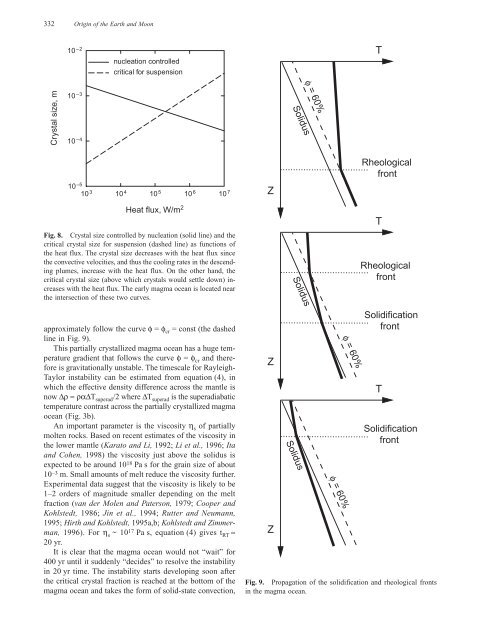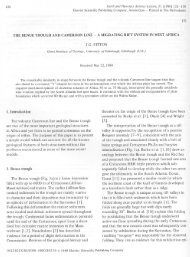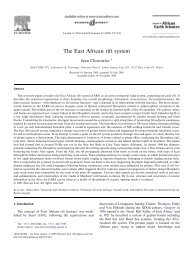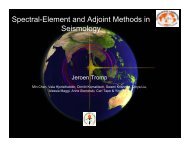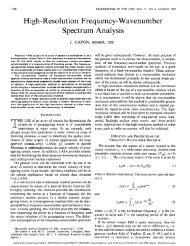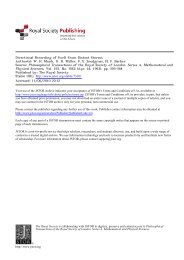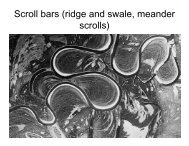332 Origin <strong>of</strong> the Earth and Moon10 –2 nucleation controlledTcritical for suspensionCrystal size, m10 –310 –4Solidusφ = 60%10 –510 3 10 4 10 5 10 6 10 7ZRheologicalfrontHeat flux, W/m 2Fig. 8. Crystal size controlled by nucleation (solid line) and thecritical crystal size for suspension (dashed line) as functions <strong>of</strong>the heat flux. The crystal size decreases with the heat flux sincethe convective velocities, and thus the cooling rates in the descendingplumes, increase with the heat flux. On the other hand, thecritical crystal size (above which crystals would settle down) increaseswith the heat flux. The early magma ocean is located nearthe intersection <strong>of</strong> these two curves.SolidusTRheologicalfrontapproximately follow the curve φ = φ cr = const (the dashedline in Fig. 9).This partially crystallized magma ocean has a huge temperaturegradient that follows the curve φ = φ cr and thereforeis gravitationally unstable. The timescale for Rayleigh-Taylor instability can be estimated from equation (4), inwhich the effective density difference across the mantle isnow ∆ρ ≈ ρα∆T superad /2 where ∆T superad is the superadiabatictemperature contrast across the partially crystallized magmaocean (Fig. 3b).An important parameter is the viscosity η s <strong>of</strong> partiallymolten rocks. Based on recent estimates <strong>of</strong> the viscosity inthe lower mantle (Karato and Li, 1992; Li et al., 1996; Itaand Cohen, 1998) the viscosity just above the solidus isexpected to be around 10 18 Pa s for the grain size <strong>of</strong> about10 –3 m. Small amounts <strong>of</strong> melt reduce the viscosity further.Experimental data suggest that the viscosity is likely to be1–2 orders <strong>of</strong> magnitude smaller depending on the meltfraction (van der Molen and Paterson, 1979; Cooper andKohlstedt, 1986; Jin et al., 1994; Rutter and Neumann,1995; Hirth and Kohlstedt, 1995a,b; Kohlstedt and Zimmerman,1996). For η s ~ 10 17 Pa s, equation (4) gives t RT ≈20 yr.It is clear that the magma ocean would not “wait” for400 yr until it suddenly “decides” to resolve the instabilityin 20 yr time. The instability starts developing soon afterthe critical crystal fraction is reached at the bottom <strong>of</strong> themagma ocean and takes the form <strong>of</strong> solid-state convection,ZZSolidusφ = 60%φ = 60%SolidificationfrontTSolidificationfrontFig. 9. Propagation <strong>of</strong> the solidification and rheological frontsin the magma ocean.
Solomatov: <strong>Fluid</strong> <strong>Dynamics</strong> <strong>of</strong> <strong>Terrestrial</strong> <strong>Magma</strong> <strong>Ocean</strong> 333which is the primary mechanism <strong>of</strong> crystallization beyondthe critical crystal fraction (Solomatov and Stevenson, 1993b).Therefore a complete solidification front would follow therheological front toward the surface (Fig. 9).10. DIFFERENTIATION IN THESHALLOW MAGMA OCEANAfter the rheological front reaches the surface, the drivingforce for this type <strong>of</strong> convection motion disappears andit stops. All important changes occur when the potentialtemperature decreases from liquidus to the critical temperaturefor the rheological transition. The crystal size becomeslarger than the critical one for suspension, the heat fluxdrops, convection slows down, and a stable crust forms atthe surface, reducing further the intensity <strong>of</strong> convection andthe cooling rate <strong>of</strong> the magma ocean.The lower bound on the depth H shallow <strong>of</strong> the remainingshallow magma ocean can be obtained from an adiabat startingat the critical temperature for the rheological transition.Figure 1 suggests that such an adiabat intersects solidusaround 10 GPa or H shallow ~300 km. This estimate is ratheruncertain since even a 100 K error in the estimate <strong>of</strong> therheological transition increases H shallow by a factor <strong>of</strong> 2.Besides, small superadiabatic gradients can be preserved fora long time and can increase the estimate <strong>of</strong> H shallow substantially— note that both solidus and liquidus are quiteflat between 10 and 23 GPa and even small superadiabatictemperatures can extend the depth <strong>of</strong> the shallow magmaocean all the way through the bottom <strong>of</strong> the upper mantle.The presence <strong>of</strong> water would also increase H shallow althoughthe melt fraction in the temperature range between “dry”solidus and “wet” solidus is small so that “dry” solidusmight still be a reasonable basis for defining the depth <strong>of</strong>the shallow magma ocean.Moreover, when the potential temperature drops belowliquidus, the completely molten layer disappears and thesequence “nucleation-growth-dissolution” changes to just“growth.” In this case, the crystals had enough time to reachthe critical size for the cessation <strong>of</strong> suspension (equations(23) and (34)). Although liquidus is only 300 K abovethe critical temperature for the rheological transition, thebottom <strong>of</strong> the shallow magma ocean can extend well intothe lower mantle, probably around 40 GPa or so (Fig. 3; seealso Miller et al., 1991b; Solomatov and Stevenson, 1993b;Abe, 1997).Differentiation in the shallow magma ocean takeswhereutpercdiffHshallow~ (35)upercg∆ρdφl=150η1− φl2 2( )l(36)is the percolation velocity according to the Ergun-Orningformula (Soo, 1967; Dullien, 1979) and φ l is the melt fraction.For example, it takestdiff~10822φld ηlyr− 3(37)002 . 10 m 100 Pa sto reduce the average melt fraction to about 2%. Note thathere we used the value <strong>of</strong> the viscosity <strong>of</strong> a low-pressure,high-silica, polymerized magma just above the solidus(Kushiro, 1980, 1986). Melt/crystal density inversions (Agee,1998) might result in the formation <strong>of</strong> more than one moltenlayer. In particular, a gravitationally stable molten layercould be formed at the bottom <strong>of</strong> the upper mantle in additionto the shallow magma ocean beneath the crust. Coolingand further crystallization <strong>of</strong> these magmatic layerswould take an even longer time depending on the globalthermal evolution <strong>of</strong> the mantle. It can be as fast as 10 7 –10 8 yr (Davies, 1990). However, if surface recycling wasinefficient, convection beneath the solid crust would beslower (e.g., Solomatov and Moresi, 1996), and crystallizationtime would be significantly larger.11. DISCUSSION AND CONCLUSIONAlthough the uncertainties in fluid dynamics <strong>of</strong> magmaoceans are substantial, the following scenario <strong>of</strong> evolution<strong>of</strong> a terrestrial magma ocean can be suggested.A giant impact melts a significant part <strong>of</strong> one hemisphere<strong>of</strong> the Earth. Isostatic adjustment quickly redistributes themass to create a more stable spherically symmetric configuration.In the beginning <strong>of</strong> crystallization <strong>of</strong> the magmaocean, the temperatures in the deepest parts <strong>of</strong> the Earthwere probably near the solidus and depended on the poorlyconstrained preimpact thermal state <strong>of</strong> the mantle. Thisimplies that some portion <strong>of</strong> the lower mantle could retainsubstantial amounts <strong>of</strong> primordial volatiles.Crystallization starts from the bottom and in less than1000 yr propagates through the lower mantle. During thisperiod <strong>of</strong> time, convection can prevent fractionation <strong>of</strong> crystalsup to the critical crystal fraction around 60% (rheologicaltransition from a low-viscosity suspension to a highviscositypartially molten solid), provided the crystals aresmaller than 10 –3 m. Kinetics <strong>of</strong> nucleation and crystalgrowth suggest that this is a possibility. Solid-state convectionhelps further cooling and crystallization <strong>of</strong> the partiallymolten mantle down to the solidus and below. The product<strong>of</strong> this period <strong>of</strong> crystallization is essentially undifferentiatedmantle with the remaining shallow partially moltenlayer. This precludes a severe fractionation <strong>of</strong> minor andtrace elements (Kato et al., 1988a,b; Ringwood, 1990;McFarlane and Drake, 1990; McFarlane et al., 1994). Smallamounts <strong>of</strong> crystals might settle down and contribute to theformation <strong>of</strong> an Fe-rich D" layer.The shallow magma ocean is the only part <strong>of</strong> the mantlethat undergoes any substantial differentiation. This can bereconciled with the observed ratios <strong>of</strong> major and minor el-


